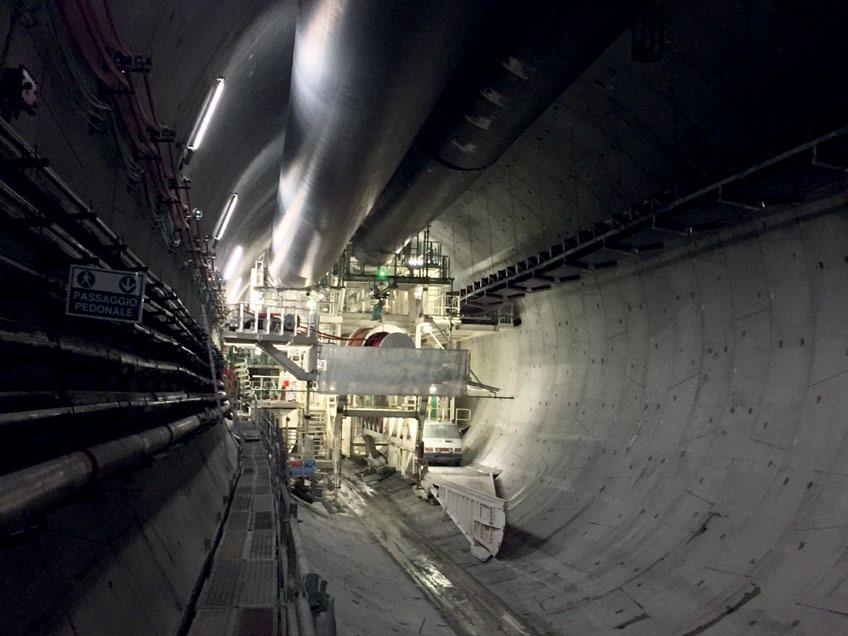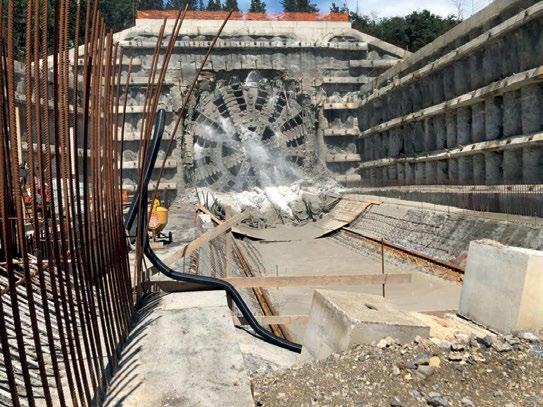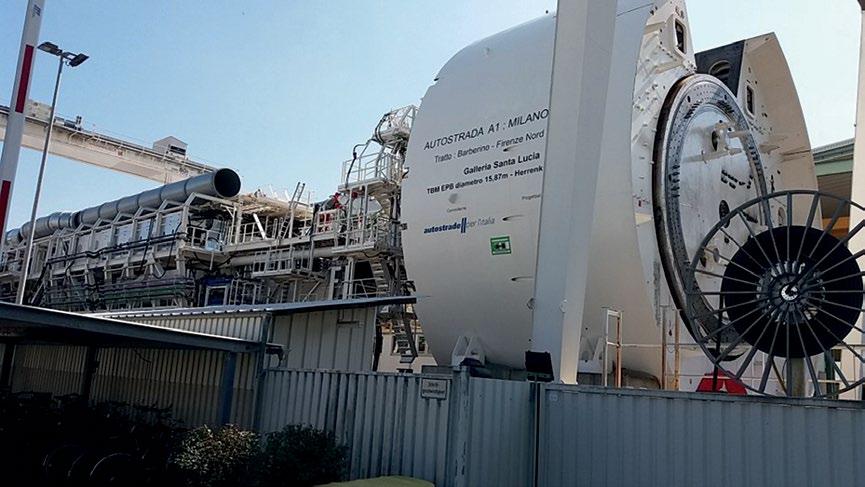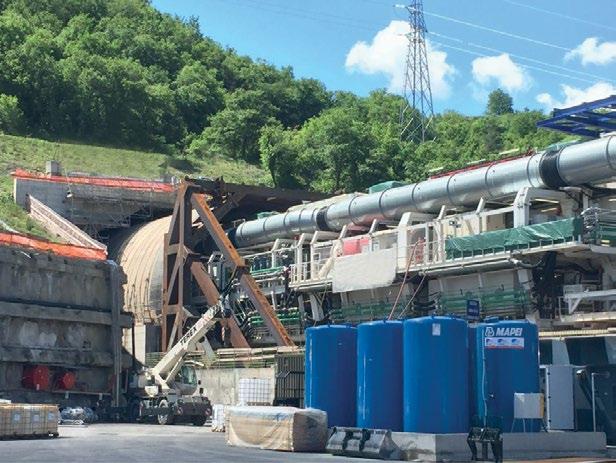
3 minute read
The Santa Lucia Tunnel
A range of chemical products were used in the construction of the longest three-lane tunnel in Europe.
The Apennine stretch of the A1 Milan-Naples motorway between Bologna and Florence in Central Italy is a winding road with numerous climbs and descents, that can be hazardous for both cars and lorries. The 37 km-long A1 ‘Variante di Valico’ link-road between La Quercia and Aglio, which opened in 2015, has reduced drive times.
The upgrade to the A1 along this stretch included the construction of a new lane on the south-bound carriageway towards Rome and a complete rebuild of the two existing lanes on the north-bound carriageway for traffic heading towards Milan. The Santa Lucia tunnel, along the stretch running between Barberino di Mugello and Firenze Nord, is one of the largest works carried out on the southbound carriageway.
A complex feat of engineering Inaugurated in March, 2022, the Santa Lucia road tunnel is 7,734 m long. An EPB (Earth Pressure Balance) TBM (Tunnel Boring Machine), with a diameter of 15.87 m, was used to bore the tunnel –the largest in Europe at the time of commencing work. The project was particularly complex due to local geological conditions and the potential presence of explosive underground gases.
The area that had to be bored, around 200 m2, enabled the construction of three lanes with a width of 3.75 m each, as well as an embankment, a pavement, ventilation and lighting systems and, under the road itself, an escape tunnel to evacuate drivers, in the event of emergencies.
As tunnelling with the TBM advanced, segments made up of nine precast reinforced concrete elements were installed in sequence.
The tunnelling technology adopted by the main contractor enabled the tunnel to be constructed at a rate of 9 m per day.

Constant control of hydraulic loads during tunnelling was fundamental in preventing any impact on the water resources, both during tunnelling operations and from a more long-term perspective. In addition, the tunnel was constructed without interfering with the flow of traffic on the surface.
Two aspects characterised this site – the actual dimensions of the tunnel and its impact on the environment. One of the largest in Italy and in the world, right from the start, the Santa Lucia tunnel project was particularly focused on minimising the impact of the products, used to condition the soil during tunnelling, on the environment.
Mapei UTT provided continuous support during tunnelling operations, constantly checking and ensuring that the optimal dosage rates of the products selected were applied, in order to condition the soil correctly and in the injection of the backfill grout.

Products for tunnelling and conditioning the soil
To make the precast reinforced concrete elements for the segments
(each one measuring 2.2 m long and 55 cm thick, and weighing 16 tonnes), the mix designs used were formulated with DYNAMON NRG 1015 SC and DYNAMON NRG 1037 superplasticisers, developed specifically for this site. MAPEFORM W60 universal form-release agent was
used for the formwork.
During tunnelling operations, the soil in the area around the shield was conditioned with POLYFOAMER ECO 100, a foaming agent made from surfactants combined with a natural lubricating polymer. This product differs from traditional foaming products, due to its low environmental impact on water and on the ground conditioning. It was chosen for this project because it offered the best performance and environmental properties from amongst all those tested during the preliminary phase.
Testing was carried out in the laboratories of Politecnico di Torino university, where conditioning tests were performed, and in the CNR (Italian National Research Council) laboratory in Rome, which carried out environmental biodegradability and eco-toxicity tests.
Muck excavated and conditioned with POLYFOAMER ECO 100 could be taken from site and transported to its destination quickly. Using POLYFOAMER ECO 100 for the whole of the tunnel excavation enabled the contractor to carry out tunnelling quickly and safely, and also to reduce its environmental impact on the ground to a minimum. In total, around 1.7 million m3 of soil were excavated and conditioned with POLYFOAMER ECO 100. The backfill grout was injected through 10 individual lines at an average flow rate of 30 litres/minute to 50 litres/minute, depending on the advance rate of the TBM. Keeping the injection pressure slightly higher than that of the EPB guaranteed that the mortar completely filled the annular voids and gaps between the concrete blocks and the ground.

The annular voids between the segments and the ground were filled with a two-component cementitious mix containing two Mapei admixtures – MAPEQUICK CBS SYSTEM 1L retardant and MAPEQUICK CBS SYSTEM 3 accelerator.
Any defects found in the concrete were repaired with mortars from the MAPEFER, MAPEGROUT and PLANITOP ranges.
Injections of RESFOAM 1 KM FLEX one-component, flexible polyurethane resin were carried out behind the concrete segments where infiltrations of water were found.
PROJECT DATA
Project
Santa Lucia tunnel
Location
A1 Milan-Naples highway, between Barberino di Mugello and Firenze Nord, Italy
Owner
Autostrade per l’Italia SpA
Contractor
Pavimental SpA
Period of construction
2016-2022
INTERVENTION BY MAPEI
Period of the intervention
2016-2022
Contribution by Mapei
Supply of admixtures for concrete, and products for soil conditioning and concrete repair
Application of Mapei products
Concrete admixtures –DYNAMON NRG 1015 SC, DYNAMON NRG 1037, MAPEFORM W60
Ground conditioning –POLYFOAMER ECO 100, DEFOAMER XP/IO 1
Backfill grout admixtures –MAPEQUICK CBS SYSTEM 1L, MAPEQUICK CBS SYSTEM 3
Concrete repair – MAPEFER, MAPEGROUT EASY FLOW GF, PLANITOP 200, PLANITOP SMOOTH & REPAIR R4, RESFOAM 1 KM FLEX
Website for further information www.mapei.com/sg utt.mapei.com
This editorial feature is based on an article from Realtà MAPEI INTERNATIONAL Issue










